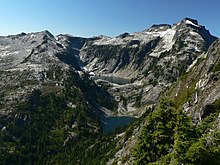North Cascades National Park
| North Cascades National Park | |
|---|---|
 | |
| Lua error in Module:Location_map at line 526: Unable to find the specified location map definition: "Module:Location map/data/USA relief" does not exist. | |
| Location | Whatcom, Skagit, and Chelan counties, Washington, USA |
| Nearest city | Bellingham |
| Area | 504,780 acres (204,280 ha)[1] |
| Established | October 2, 1968 |
| Visitors | 24,659 (in 2010)[2] |
| Governing body | National Park Service |
North Cascades National Park is a U.S. National Park located in the state of Washington. The park is the largest of the three National Park Service units that comprise the North Cascades National Park Service Complex. Several national wilderness areas and British Columbia parkland adjoin the National Park. The park features rugged mountain peaks.
Natural history
Glaciers

In 1971, the park had 318 glaciers with an area of 117 km2 (Post et al., 1971), the most of any US park outside Alaska. All the glaciers in the park have retreated significantly from 1980–2005 and the rate is increasing. The recent warmer climate has led to more summer melting and more winter melting events, reducing winter snowpack. Several glaciers in the range have melted away in the last decade.[3] Boston Glacier, on the north slope of Boston Peak, is the largest glacier in the park with an area of 7 km2. The other large glaciers (with areas greater than 2.5 km2) are:

- Redoubt (Mount Redoubt)
- Nooksack (Mount Shuksan)
- Sulphide (Mount Shuksan)
- Challenger (Mount Challenger)
- Inspiration (Eldorado Peak)
- McAllister (Eldorado Peak)
- Neve (Snowfield Peak)
Wildlife
Due to its wilderness nature, it is home to wolves, lynx, moose, wolverines, and many other rare or endangered species. Few grizzly sightings have been confirmed by park staff, though black bears are common. There are a gamut of mammals, birds, amphibians and reptiles. As a notable amphibian example, within the Rough-skinned Newt Cascade Mountains populations, approximately ninety percent of the adult population is perennibranchiate.[4]
Plants
Extreme variation, in rock and soil types, exposure, slope, elevation, and rainfall is reflected in the diverse plant life. Eight distinctive life zones support thousands of different plant species in the North Cascades greater ecosystem. No other National Park surpasses North Cascades National Park in the number of plant species recorded. Over 1,630 vascular plant species have been identified, and estimates of non-vascular and fungal species could more than double this number for total plant species in the North Cascades.[5] The park contains an estimated 236,000 acres (960 km2) of old-growth forests.[6]
Geography

Attractions
Nearly all of the national park is protected as the Stephen Mather Wilderness, so there are few maintained buildings and roads within the North and South units of the Park. The park is most popular with backpackers and mountain climbers. One of the most popular destinations in the park is Cascade Pass, which was used as a travel route by Native Americans. It can be accessed by a four-mile (6 km) trail at the end of a gravel road. The North and South Picket Ranges, Mount Triumph, as well as Eldorado Peak and the surrounding mountains, are popular with climbers due to glaciation and technical rock. Mount Shuksan, in the northwest corner of the park, is one of the most photographed mountains in the country and the second highest peak in the park 9,127 ft (2,782 m)*.

Access
Although one gravel road open to the public enters the park, most automobile traffic in the region travels on the North Cascades Highway (Washington State Route 20), which passes through the Ross Lake National Recreation Area. The nearest large town on the west side of the park is Sedro-Woolley, Washington, while Winthrop lies to the east. Chelan is located at the southeastern end of Lake Chelan.
See also
- Skagit Valley Provincial Park
- Mount Baker Wilderness
- Glacier Peak Wilderness
- Pasayten Wilderness
- Lake Chelan-Sawtooth Wilderness
- Retreat of glaciers since 1850
- North Cascades
References
![]() This article incorporates public domain material from websites or documents of the National Park Service.
This article incorporates public domain material from websites or documents of the National Park Service.
- ^ "Listing of acreage – December 31, 2010" (XLSX). Land Resource Division, National Park Service. Retrieved 2011-06-21. (National Park Service Acreage Reports)
- ^ "NPS Annual Recreation Visits Report". National Park Service. Retrieved 2011-06-21.
- ^ Glacier Retreat in the Pacific Northwest North Cascades National Park
- ^ C. Michael Hogan. 2008. Rough-skinned Newt (Taricha granulosa), Globaltwitcher, ed. Nicklas Stromberg [1]
- ^ "Plants". United States National Park Service: North Cascades National Park Service Complex. Retrieved January 13, 2009.
- ^ Bolsinger, Charles L.; Waddell, Karen L. (1993). "Area of old-growth forests in California, Oregon, and Washington" (Document). United States Forest Service, Pacific Northwest Research Station. Resource Bulletin PNW-RB-197.
{{cite document}}: Unknown parameter|url=ignored (help)
- Post, A. (1971). "Inventory of glaciers in the North Cascades, Washington". USGS Prof. Paper. 705-A: A1–A26.
{{cite journal}}: Unknown parameter|coauthors=ignored (|author=suggested) (help)
External links
- Official site: North Cascades National Park
- Education: North Cascades Institute
- Guide to North Cascades National Park on Compassmonkey.com
- Glacier Research: North Cascade Glacier Climate Project reports
- Conservation: The North Cascades Conservation Council
- Expansion project: The American Alps Legacy Project seeks to expand and complete the Park as envisioned by its founders

